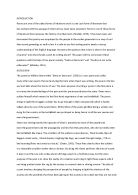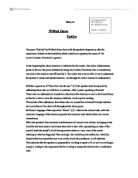Stanza 3 has just two lines, this makes it stand out from the rest of the poem, giving prominence and drawing the reader’s eye. He describes his own experience here being helpless to save the “drowning man” who “plunges” toward him, perhaps seeking help. Owen could only watch helplessly. He says “in all my dreams”, meaning that he will never forget this incident.
Stanza 4 opens with Owen asking the reader to imagine pacing behind the wagon, into which the gassed man had been flung. He relates his own experience of watching the man’s sufferings as in his own “smothering dreams”. Owen uses vivid description as he tells of the effects of gas upon the injured man; this produces strong emotions of revolt and disgust in the reader. Describing the face in simile form with “like a devil’s sick of sin”, Owen produces an awful image of agony, as does “his white eyes writhing, in his hanging face”. Owen goes on to ask the reader to listen to the awful sounds coming from the man, using onomatopoeia with the word “gargling” to describe blood from “froth-corrupted” lungs. Owen goes on to relate his own feelings about his comrades injuries, “Obscene as cancer, bitter as the cud”, similes meaning Owens emotional response to this was like the taste of vomit in the mouth “of vile, incurable sores in innocent tongues” refers to the youth of the soldiers, innocent like children, now corrupted with war.
The last four lines of stanza four have Owen speaks directly to the reader; he may have even intended this for a particular person or group of people. He says that he is talking with “high zest” meaning it is important and emotive; he wants to be heard and is uses the medium of his poetry for this. Owen asks that children, who may be seeking glory and admire soldiers, be not told the lie, “How sweet and decorous it is to die for your country”. He is referring to propaganda, which glorifies soldiers and war. His tone of disillusionment, anger and disgust.
Spring Offensive
This poem has six stanzas; it was completed in 1918 shortly before Owen’s death. The tone of this poem is solemn It is a record of battle, its consequences and the soldiers who fought. Owen narrates the events rather than recording his own experiences, he is the observer. Using the word “Offensive” in the title, Owen intended a double meaning. Firstly and most obvious the position of attack or hostile action “offensive” has another meaning, unpleasant or disgusting to the senses. Owen clearly wanted the reader to consider their attitude to war.
The first stanza opens with a description of the men halted at a “last hill”; this term can be translated meanings, the last hill before battle, the last hill before some will die, therefore making this a metaphor the end of the world. Ironically, this was Wilfred Owen’s last poem, so his own “last hill”. There is a pause here, where the soldiers rest, they have the opportunity to ponder and contemplate the future including the realistic possibility of imminent death. In the second part of this stanza, Owen describes the scenery, not unlike an English countryside in spring. He uses onomatopoeia when he describes the sound of insects as “murmurous”. He uses onomatopoeia when he describes the healing power of nature as “oozed” and further describes the atmosphere and mood of the soldiers in simile form as “like an injected drug for their bodies’ pains”; here Owen describes the use of opiates, which was far more acceptable at the time, for example in Opiate dens. The last two lines bring the reader back to reality. Owen uses the sharpness of “S” sounds to illustrate the feeling of the men as they watch the sky flash like a “mysterious (looking)-glass” or mirror, as the battle continues in the distance.
Slow boots in the second stanza describe the slow and difficult advance to their present position, when they ponder the “warm field and the far valley behind” is a metaphor for considering previous battles fought. Their boots had been “blessed with gold” this being a precious colour of the growing flowers “buttercups”, implies some divine assistance with the battle. Describing how the brambles had “clutched and clung” to the soldiers is how a child would hold onto the father, trying to stop him leaving for the war. The last line of this stanza again refers to nature when he describes the men in simile form as being “like trees” breathing unstirred as they stand and contemplate.
A metaphor opens the third stanza, “like a cold gust” that would send a chill down ones spine. The “little word” is the order to ready for battle. There is no excitement at this stage, perhaps a resignation to the forthcoming battle. The men lift their eyes and look into the sun “with whom their love is done” this indicates that they are facing the glare of the sun and their vision is limited, this is why they no longer love or appreciate it, no longer is it of benefit, more a hindrance.
Stanza 4 describes the charge as the man ‘go over the top’ and into battle. They top the “hill” out of the trench and become exposed and vulnerable. Owen demonstrates stark contrast between the horror and war and nature when he describes them crossing the normally idyllic stretch of “herb and heather”: these words making soft and warm sounds. As soon as they are visible to the enemy, the sky looks as if it is burning with explosions. These are the same as witnessed from afar at the end of stanza one. As shells hit the ground, it opens up with “sudden cups” for the soldiers’ blood. The last line emphasises the hugeness of the craters when they are described as “sheer to infinite space”. The term “infinite space” also being a metaphor for death.
Stanza 5 describes the deaths of many soldiers’ as they ran on their “last high place”; they ran into a hale of bullets . The third and fourth lines describe men being caught in shell explosions in the “fury of hell’s upsurge” or plunging and “fell away” down the creator created. “This world’s last verge” being a metaphor for death. The stanza ends “Some say God caught them –before they fell” this again has two meanings, first that the men were dead before the hit the ground and second that they never had any hope of surviving this battle. This stanza does not speak of nature at all; there is no easing of the burden of death.
The final stanza speaks of the survivors of the battle: they were too fast and able to avoid the bullets and shells or were simply missed by the weaponry. Owen uses a metaphor to describe the battle as “hell”. He says that as survivors by “out-fiending all its fiends and flames” again a metaphor, they were worse or did more evil than would be done in hell, “superhuman inhumanities” The next line describes how this battle will be recorded in history as a “long-famous glory” however the “immemorial shames” will be forgotten. The last three lines describe the men “crawling back” perhaps to avoid the bullets from German guns that could not fire at the ground. “by degrees” slowly wonder at surviving this battle against the odds. They regain the “peaceful air” as described in stanzas one and two.
The last line of the last stanza asks “Why speak not of comrades who went under?” Owen not only speaks of the dead, but also those buried alive when shell explosions move huge quantities of soil. The survivors do not want to think of death, they do not want to speak of them because they died for no reason, without purpose.
Anthem for a doomed youth
Owen has written this poem in sonnet form, which is a poem of fourteen lines arranged in a definite rhyme scheme
The title of the poem foretells the fate of soldiers, being “doomed”. An anthem is a song of loyalty or devotion and utilises religious ideation, Owen demonstrates irony, as there would have been little loyalty or devotion for the soldiers. Owen speaks of ‘youth’ in the singular; however, the poem clearly speaks of soldiers (plural). This brings home to the reader that each of those that the poem refers to is an individual, a father, husband, brother, son or lover. Throughout the poem, Owen uses religious ideation and symbolism to contrast the realism of trench warfare.
The first three lines of the poem are a question and its answer. Owen again uses religious symbolism when he asks, “What bell tolls”. He goes on “for those who die as cattle?” Here he is using this simile as a metaphor for an abattoir, meaning that the battlefield must resemble a slaughterhouse. He answers his question with a description of the only sound that could represent a bell, the “monstrous” sound, meaning hideous, unnatural and unjust sound of guns; then using onomatopoeia with “stuttering rifles’ rapid fire” to demonstrate that sound to the reader. Further, in line four Owen relates that only the sound of this weaponry can “patter out” their “hasty orisons” or prayers. To patter is to repeat prayers in a mechanical or perfunctory manner.
The last four lines of the first stanza illustrate there are no religious rites or rituals for the soldiers; Owen uses personification of the “wailing shells” when he refers to them as “demented choirs” mourning those killed. Finally Owen refers to “bugles calling – from sad shires”, here he utilises the imaginary call of those missing the soldiers from the British “shires”.
The second verse starts with a further question and its answer: using the contrast of religious imagery to the realism of loss and bereavement. Owen asks, “What candles – to speed them all”, to speed the dead souls to heaven. He answers there are no candles, only glimmers in the eyes of boys who say goodbye to the dead. The boys referred to are the young soldiers, comrades in arms rather than alter boys. Personification in the pall, or coffin cover in the form of the paleness or pallor of girls, the girls being the wives, mothers and girlfriends left behind to grieve their loves: suffering, as if patiently and tender. The “slow dusk” as the grieving mourn and the “drawing of blinds” portraying an air of closure, sadness and loss for those young lives lost in war with no ritual or meaning.
Bibliography
AOL, 2003 New Oxford Dictionary of English AOL UK
Sinclair J M, General Consultant, 2001: Collins Concise Dictionary Harper Collins Publishers. Glasgow.
Wilfred Owen Association.
http://www.1914-18.co.uk/owenspoems/index.htm







